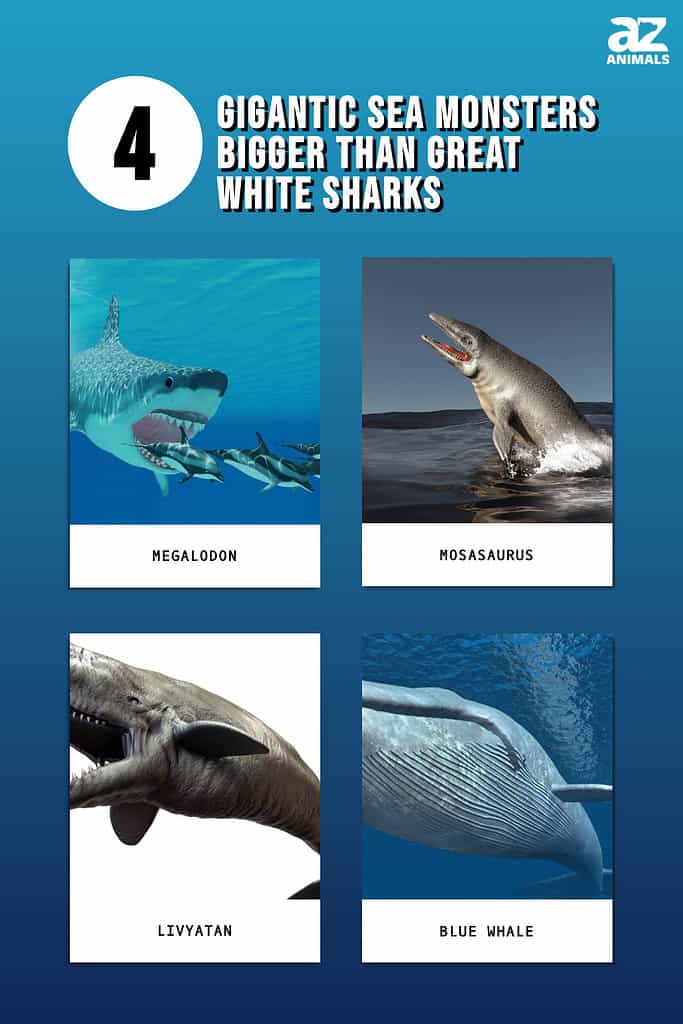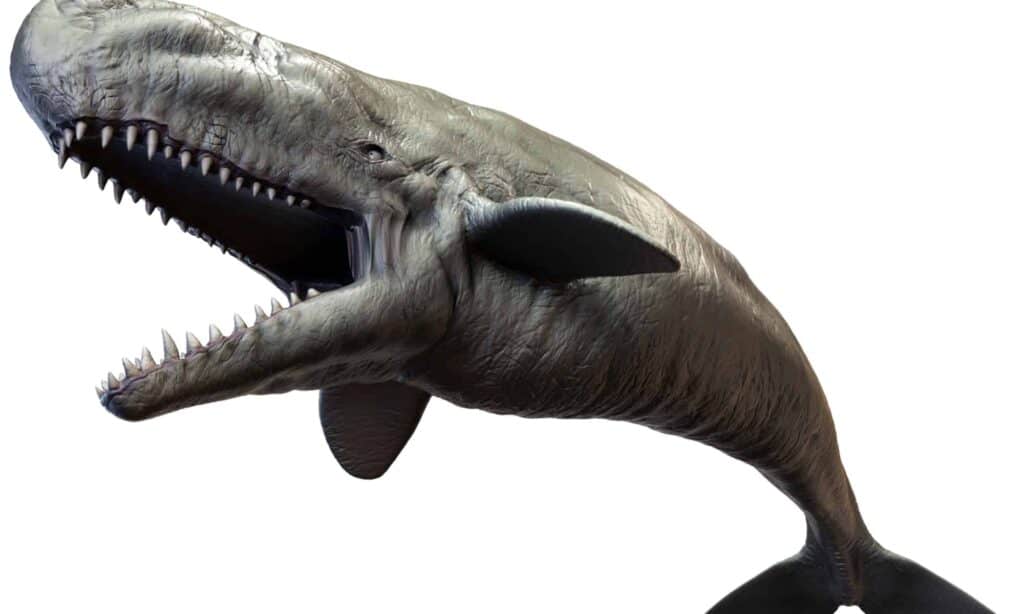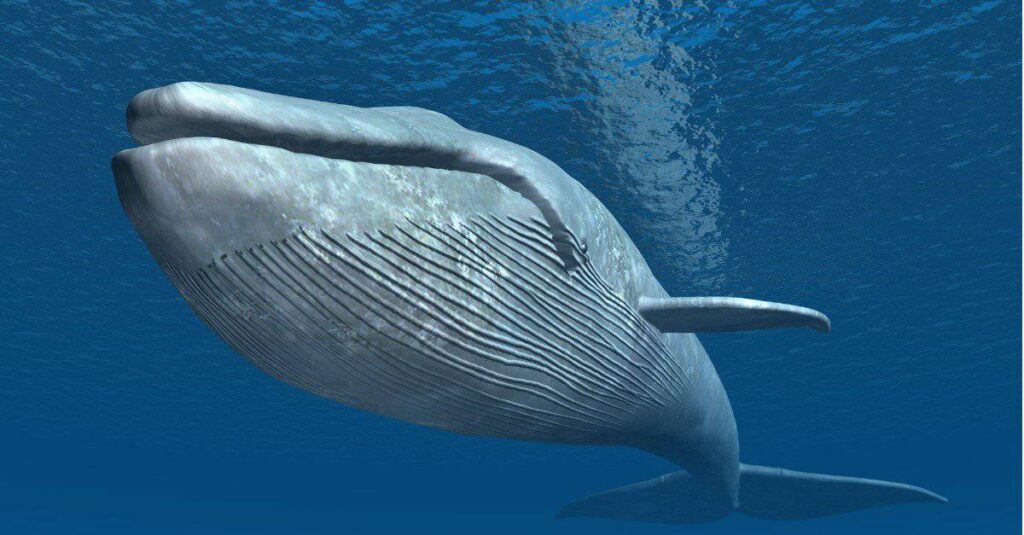Currently, the largest predatory fish on earth are great white sharks. The great white shark is a massive shark that may be found mostly in coastal waters in temperate and tropical regions of the world. These sharks can get as big as 5,000 pounds (2.5 tons) and reach lengths of 20-plus feet, and they have ruled the oceans for more than 20 million years. Other than the great white shark, though, there are/were four bigger sea monsters:

With their massive, torpedo-shaped bodies and pointed snouts, great white sharks, like nearly all shark species, have a very unique appearance. Another feature that makes them stand out is their dentition. They have up to 300 serrated, triangular teeth arranged in rows and replaced continuously throughout their life. These teeth can grow as long as six centimeters.
Despite being so huge, there are other sea monsters bigger than great white sharks. In no particular order, let’s learn more about these species.
Megalodon

The Megalodon’s size has been extensively studied, with the largest specimens measuring up to 58.7 feet long.
©Catmando/Shutterstock.com
The Megalodon was a massive species of shark that existed from the Early Miocene period (about 23 million years ago) to the Late Miocene (roughly 6 million years ago). Although these sharks existed long before humans, evidence from the fossils found shows that these sharks were bigger than any shark that currently exists, including the great white shark. The Megalodon’s size has been extensively studied, with the largest specimens measuring up to 58.7 feet long. However, some scientists suggest it may have measured up to 82 feet long. This shark is also estimated to have weighed between 60,000 and 100,000 pounds, making it larger than any shark that has ever existed.
Apart from its massive size, the Megalodon also had long teeth, with each one reaching lengths of around six to seven inches. This is more than twice the largest great white shark teeth, which measure between 1.5 and 2.5 inches long. Megalodon sharks were distributed worldwide in non-polar waters, just like great white sharks are now, but their range kept growing through time. During the early existence of these sharks, it is believed that they primarily inhabited the Caribbean, the Mediterranean Sea, and Australia. The species was more frequently found in places like South Africa and traveled around a lot, spreading over North and South America.
Mosasaurus

Mosasaurus measured up to 56 feet long and 30,000 pounds.
©Esteban De Armas/Shutterstock.com
The Mosasaurus existed during the Late Cretaceous Era from about 70 million to 66 million years ago. These animals were gigantic aquatic lizards that lived at the same time as dinosaurs but were not related. Scientists estimate that they were about 46 to 56 feet long, and although they were reptiles, they still bore a close resemblance to modern-day whales. Apart from being incredibly long, these animals were also huge, with many of them weighing over 30,000 pounds. Despite being reptiles, the Mosasaurus had certain features that helped it adapt to the ocean, like whales and other sharks. Their soft tissue tail featured two lobes and a small downward bend toward the end. They had paddle-like forelimbs and hindlimbs, which they used for swift swimming. The Mosasaurus also had double-hinged jaws that made it possible for it to swallow its prey whole.
According to fossil data, Mosasaurus lived in a significant area of the Atlantic Ocean and its nearby seaways. The Americas, Africa, Europe, Asia, and Antarctica are just a few of the places where this species’ fossils have been discovered. This implies that the creature was not limited to one habitat, and its natural habitat included a variety of climatic settings, such as tropical, subtropical, polar, and temperate regions. Experts have connected the extinction of the Mosasaurs, which happened around 65 million years ago, to the Cretaceous-Paleogene extinction brought on by a massive asteroid that struck the earth.
Livyatan

Livyatan weighed as much as 120,000 pounds.
©Herschel Hoffmeyer/Shutterstock.com
The Livyatan is another sea creature larger than great white sharks that lived during the same period as the Megalodon. These creatures existed in the Miocene epoch, around 9.9 million to 8.9 million years ago in the Upper Miocene during the Neogene period. They grew as large as 44 to 57 feet and weighed as much as 120,000 pounds. However, the accurate size of these creatures remains unknown because of the limited fossils, as the only fossils found of these animals are a skull and some teeth. The Livyatan skull was almost 10 feet long, and comparing it to its living relative, modern sperm whales, experts have been able to make an estimate regarding the animal’s size.
Apart from its massive size, the Livyatan had the largest teeth of any discovered animal. This animal had teeth that grew as long as one foot, making it easy for it to tear off the flesh of its prey. Also, the way the teeth of this animal were arranged shows that they were interlocked to keep prey and other smaller creatures from escaping the creature’s mouth. The only fossils from Livyatan that have been positively identified were discovered in Chile and Peru. In November 2008, the first fossil, a skull, of this sea monster was found. The lower jaw and some teeth were still present in the partially preserved skull. The skull was discovered in Peru’s Pisco Formation rocks.
Blue Whale

Blue whales are the largest living animals in the world.
©iStock.com/MR1805
The blue whale is a large species of whale that may be found all over the world in polar and subtropical environments. The average blue whale grows as long as 100 feet and can weigh up to 200 tons (400,000 pounds). Blue whales are the largest living animals today, with the largest ever weighing 418,878 pounds.
These whales are baleen whales, which means they lack teeth like other whales and sharks and instead have up to 395 plates of hard material that resemble bristles and hang from the top mouth to filter food from the water. The blue whale’s diet consists of krill—tiny shrimp-like animals, but fish and copepods (tiny crustaceans) may be eaten on occasion. Thus, the great white shark is the largest predatory fish, but the blue whale is the largest mammal, indeed the largest animal, to ever live on earth.
Blue whales can be found all over the world in both arctic and tropical oceans, and they move between the two at various times of the year. The IUCN currently lists the blue whale as an endangered species since there are believed to be fewer than 20,000 of them left in the globe. Although these animals are not hunted by humans as much anymore, they are subject to climate change and accidents caused by ships.
Summary of 4 Gigantic Sea Monsters Bigger Than Great White Sharks
Here’s a recap of the four enormous sea monsters that were larger than today’s great white shark, which can grow to lengths of more than 20 feet and weigh up to 5,000 pounds, that we took a look at.
| Number | Sea Monster | Time of Existence | Length | Weight |
|---|---|---|---|---|
| 1 | Megalodon | Early Miocene period (about 23 million years ago) to the Late Miocene (roughly 6 million years ago) | Up to 58.7 feet long, with some thought to have measured up to 82 feet | 60,000-100,000 pounds |
| 2 | Mosasaurus | Late Cretaceous era from about 70 million to 66 million years ago | 46-56 feet | More than 30,000 pounds |
| 3 | Livyatan | Miocene epoch, approximately 9.9 to 8.9 million years ago | 44-57 feet | 120,000 pounds |
| 4 | Blue Whale | Present | 100 feet | 400,000 pounds |
The photo featured at the top of this post is © Wild_and_free_naturephoto/Shutterstock.com
Sources
- Jennifer Jones, Available here: https://largest.org/animals/sea-creatures/
Thank you for reading! Have some feedback for us? Contact the AZ Animals editorial team.






